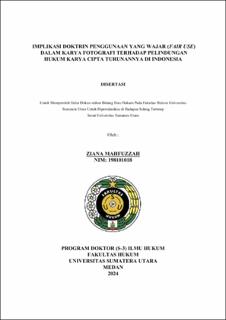| dc.contributor.advisor | Saidin | |
| dc.contributor.advisor | Ginting, Budiman | |
| dc.contributor.advisor | Azwar, Tengku Keizerina Devi | |
| dc.contributor.author | Mahfuzzah, Ziana | |
| dc.date.accessioned | 2024-11-12T08:20:20Z | |
| dc.date.available | 2024-11-12T08:20:20Z | |
| dc.date.issued | 2024 | |
| dc.identifier.uri | https://repositori.usu.ac.id/handle/123456789/98759 | |
| dc.description.abstract | Photography and its derivatives are part of creative works protected by Law Number 28 of 2014 concerning Copyright. Articles 15 and 44 in the Copyright Law provide certain exceptions or limitations that allow the use of copyrighted works without permission for specific purposes. In this context, international society recognizes a doctrine known as fair use. In some cases, misuse or misinterpretation of fair use can be used as an excuse for plagiarism. Indonesian Copyright Law (UUHC) does not yet have comprehensive parameters regarding fair use indicators.
This study is of a normative juridical type, utilizing secondary data by processing data from primary legal materials, secondary legal materials, and tertiary legal materials. Data collection techniques involve document studies, utilizing qualitative analysis.
The doctrine of fair use in the use of photographic works can be applied by fulfilling the conditions mandated by Articles 43 and 44 UUHC, namely as long as the photographic work is used for educational, security and government, legislative and judicial administration purposes that are not commercial in nature. Implementation of the doctrine of use Fair use in practice in the use of photographic works involves assessing various factors to determine whether a use is considered fair. The United States has a more detailed approach and takes into account special factors in assessing fair use, while Indonesia is more limited and requires further interpretation, making it difficult to determine whether the use of Copyright material meets the elements of fairness and reasonableness.
Therefore, the doctrine of fair use provides protection for the exclusive rights of creators of photographic works against creators of derivative works, namely by refining and strengthening the definition and criteria for derivative works in article 40 letter n UUHC as well as refining the meaning of reasonable interest in Article 44 UUHC which is not only limited to interests based on balance in enjoying the economic benefits of a Creation but is accompanied by clear parameters as has been done by the United States. Refining the meaning and criteria must pay attention to several aspects, namely providing a fair balance, consistent law enforcement and access to information. | en_US |
| dc.language.iso | id | en_US |
| dc.publisher | Universitas Sumatera Utara | en_US |
| dc.subject | Legal Protection | en_US |
| dc.subject | Photography | en_US |
| dc.subject | Derivative Works | en_US |
| dc.subject | Fair Use | en_US |
| dc.title | Implikasi Doktrin Penggunaan yang Wajar (Fair Use) dalam Karya Fotografi terhadap Pelindungan Hukum Karya Cipta Turunannya di Indonesia | en_US |
| dc.title.alternative | Implications of the Fair Use Doctrine in Photography Works on the Copyright Protection of Derivative Works in Indonesia | en_US |
| dc.type | Thesis | en_US |
| dc.identifier.nim | NIM198101018 | |
| dc.identifier.nidn | NIDN0013026203 | |
| dc.identifier.nidn | NIDN0011055902 | |
| dc.identifier.nidn | NIDN0001027001 | |
| dc.identifier.kodeprodi | KODEPRODI74001#Ilmu Hukum | |
| dc.description.pages | 283 Pages | en_US |
| dc.description.type | Disertasi Doktor | en_US |
| dc.subject.sdgs | SDGs 16. Peace, Justice And Strong Institutions | en_US |


